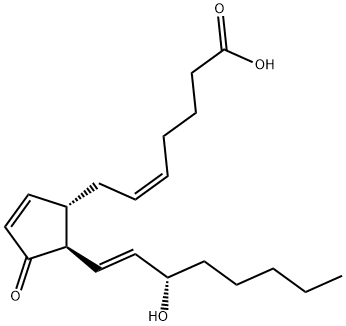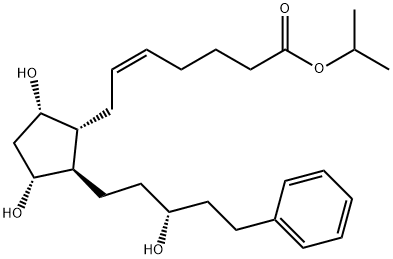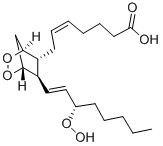PROSTAGLANDIN J2
- CAS NO.:60203-57-8
- Empirical Formula: C20H30O4
- Molecular Weight: 334.45
- MDL number: MFCD00065804
- EINECS: 201-185-2
- SAFETY DATA SHEET (SDS)
- Update Date: 2024-07-02 08:55:09

What is PROSTAGLANDIN J2?
Description
Prostaglandin J2 (PGJ2) is formed from PGD2 by the elimination of the C-
The Uses of PROSTAGLANDIN J2
PGJ2 (Prostaglandin J2) is a Prostaglandin D2 metabolite that has shown potent anti-neoplastic and antiviral activity.
What are the applications of Application
PGJ2 (Prostaglandin J2) is a Prostaglandin D2 metabolite that has shown potent anti-neoplastic and antiviral activity
Definition
ChEBI: A member of the class of prostaglandins J that consists of prosta-5,9,13-trien-1-oic acid substituted by an oxo group at position 11 and a hydroxy group at position 15 (the 5Z,13E,15S stereoisomer).
Properties of PROSTAGLANDIN J2
| Boiling point: | 521.7±50.0 °C(Predicted) |
| Density | 1.103±0.06 g/cm3(Predicted) |
| storage temp. | −20°C |
| solubility | DMF: >100 mg/ml (from PGD2); DMSO: >50 mg/ml (from PGD2); Ethanol: >75 mg/ml (from PGD2); PBS pH 7.2: >2.7 mg/ml (from 15-deoxy-.DEL |
| pka | 4.75±0.10(Predicted) |
| form | Liquid |
| color | Colorless to light yellow |
Safety information for PROSTAGLANDIN J2
Computed Descriptors for PROSTAGLANDIN J2
New Products
4-AMINO-TETRAHYDRO-PYRAN-4-CARBOXYLIC ACID HCL 4-(Dimethylamino)tetrahydro-2H-pyran-4-carbonitrile 4-Aminotetrahydropyran-4-carbonitrile Hydrochloride (R)-3-Aminobutanenitrile Hydrochloride 3-((Dimethylamino)methyl)-5-methylhexan-2-one oxalate 1,4-Dioxa-8-azaspiro[4.5]decane 5-Bromo-2-nitropyridine Nimesulide BP Aceclofenac IP/BP/EP Diclofenac Sodium IP/BP/EP/USP Mefenamic Acid IP/BP/EP/USP Ornidazole IP Diclofenac Potassium THOMAIND PAPER PH 2.0 TO 4.5 1 BOX BUFFER CAPSULE PH 9.2 - 10 CAP SODIUM CHLORIDE 0.1N CVS ALLOXAN MONOHYDRATE 98% PLATINUM 0.5% ON 3 MM ALUMINA PELLETS (TYPE 73) LITHIUM AAS SOLUTION 2-Bromo-1-(bromomethyl)-3-chloro-5-nitrobenzene 2-Bromo-3-nitroaniline N-(3-Hydroxypropyl)-N-methylacetamide 3-Bromo-6-chloropyridazine 4-ethyl-3-nitrobenzoic acidRelated products of tetrahydrofuran








You may like
-
 1-Methyl-6-oxo-1,6-dihydropyridazine-3-carbonitrile 98%View Details
1-Methyl-6-oxo-1,6-dihydropyridazine-3-carbonitrile 98%View Details
99903-60-3 -
 88491-46-7 98%View Details
88491-46-7 98%View Details
88491-46-7 -
 1823368-42-8 98%View Details
1823368-42-8 98%View Details
1823368-42-8 -
 2-(3-(tert-butyl)phenoxy)-2-methylpropanoic acid 1307449-08-6 98%View Details
2-(3-(tert-butyl)phenoxy)-2-methylpropanoic acid 1307449-08-6 98%View Details
1307449-08-6 -
 Ethyl 3-(furan-2-yl)-3-hydroxypropanoate 25408-95-1 98%View Details
Ethyl 3-(furan-2-yl)-3-hydroxypropanoate 25408-95-1 98%View Details
25408-95-1 -
 2-Chloro-5-fluoro-1-methoxy-3-methylbenzene 98%View Details
2-Chloro-5-fluoro-1-methoxy-3-methylbenzene 98%View Details
1805639-70-6 -
 1784294-80-9 98%View Details
1784294-80-9 98%View Details
1784294-80-9 -
 Lithium ClavulanateView Details
Lithium ClavulanateView Details
61177-44-4